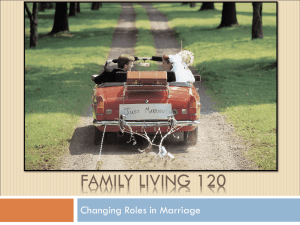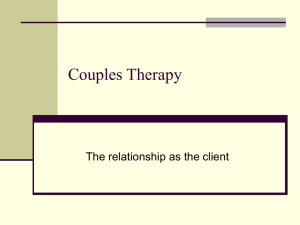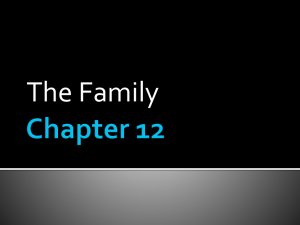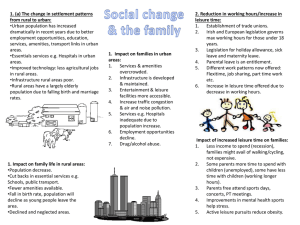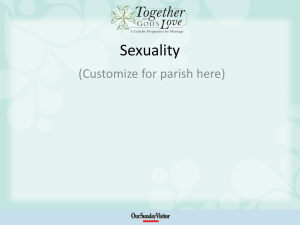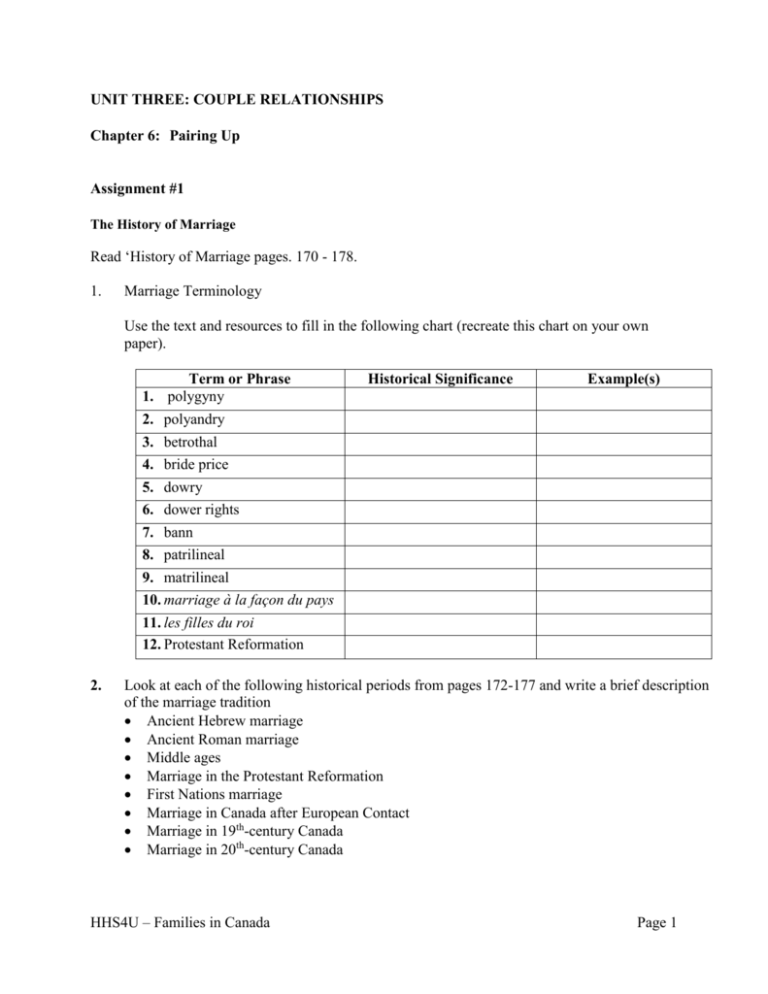
UNIT THREE: COUPLE RELATIONSHIPS
Chapter 6: Pairing Up
Assignment #1
The History of Marriage
Read ‘History of Marriage pages. 170 - 178.
1.
Marriage Terminology
Use the text and resources to fill in the following chart (recreate this chart on your own
paper).
Term or Phrase
1. polygyny
2.
3.
4.
5.
6.
Historical Significance
Example(s)
polyandry
betrothal
bride price
dowry
dower rights
7. bann
8. patrilineal
9. matrilineal
10. marriage à la façon du pays
11. les filles du roi
12. Protestant Reformation
2.
Look at each of the following historical periods from pages 172-177 and write a brief description
of the marriage tradition
Ancient Hebrew marriage
Ancient Roman marriage
Middle ages
Marriage in the Protestant Reformation
First Nations marriage
Marriage in Canada after European Contact
Marriage in 19th-century Canada
Marriage in 20th-century Canada
HHS4U – Families in Canada
Page 1
Assignment #2
Contemporary Marriage and Couple Relationships
Read ‘The Purpose of Marriage” pages. 179 - 187.
1.
“People choose to marry for personal reasons, not to fill a social role” – write down 3 points that
immediately come to mind when reflecting on this statement.
2.
Create a T-chart that outlines personal and social reasons for marriage.
Reasons for Marriage
Personal
Social
3.
Answer the following questions with your own personal opinions:
Is marriage still popular?
Who can get married?
When do people get married?
What role does money play in marriage?
4.
Look at the chart on page 185 and answer the following questions:
a) How has the ration of married to common-law opposite –sex couples changed?
b) What is the trend for same-sex couples?
5.
Look at the chart on page 186 and answer the following questions:
a) Summarize the changes in the age at first marriage for men and for women.
b) How is the age difference between men and women at first marriage changed?
c) Suggest why the age at first marriage climbed slightly in 1941.
d) Suggest why the age at first marriage declined from 1941 to 1971.
6.
Read over pages 180-184 and provide an explanation of how each theoretical perspective would
explain marriage. (you can answer using a chart similar to the one below)
Theoretical Perspective
Exchange Theory
Symbolic Interactionism
Life-Course Perspective
Functionalism
HHS4U – Families in Canada
Why People Marry
Page 2
Read “Cohabitation and Same-Sex Couples” pages. 188 - 193.
Cohabitation:
•a.k.a. Common-law relationship
•Most common choice of Canadians for first conjugal relationship
•Testing a relationship before commitment
•After 3 years of cohabitation, couple must accept mutual responsibility for support and
protection
•marriage is down because cohabitation has risen
Cohabitation Statistics
•Fewer cohabiting couples are getting married
•Common-law couples are more likely to separate than married couples
•Couples who marry after cohabiting are 2X more likely to divorce
Reasons
•Less commitment = less effort
•Less commitment of family = don’t know how to resolve problems
•Problems that were seen in common-law continue in marriage that results in Divorce
Assignment #3
1.
Look at the charts and statistical finds on cohabitation and answer the questions that follow
each chart.
a) Figure 6-19 (common-law couples in Quebec) – Page 189
b) Figure 6-20 (how marriage would change their) – Page 191
c) Figure 6-21 (reasons for and against cohabitation) – Page 192
2.
Does cohabitation have the same status as marriage, or is it an alternative relationship for
those couples who want none of the legal rights or responsibilities of marriage?
Same-Sex Couples
•
•
•
•
Legalized in Canada in 2005 by the “Civil Marriage Act”
Argument: “People choose to cohabit and/or marry based on romantic attraction, not
because of traditional responsibilities or religious beliefs”
Re-examine the purpose of marriage and the role of couple relationships on others
Same-sex marriage provides the SAME protection to partners and their children as does
heterosexual marriage
HHS4U – Families in Canada
Page 3
Assignment #4
The Future of Couple Relationships
Read “The Future of Couple Relationships” pages. 193 - 195.
1.
Read the Case Study – Sarah Gets Married – pages 194 – 195 and answer the following
questions:
a) What factors affected Sarah’s choice not to marry earlier?
b) What reasons explain why Sarah and Ian married when they did?
c) Speculate on the likelihood that this example of the marriage process will become the
norm in Canada.
2.
Create a collage of a collection of pictures of couples from various media sources, such as
television, movies, music videos, sports, novels etc. Your collage should be presented on a
8.5 by 11 piece of paper.
Chapter 7: Becoming a Couple
Attraction, Male Selection and Romance
Read “Theories of Attraction and Mate Selection” pages. 200 - 209.
Marriage in Canada
• Most marriages in Canada are a result of free-choice mate selection where people are
attracted to one another, fall in love, and make the decision to marry
• There are several theories that can be used to explain the attraction between individuals
and the unconscious choices people make when they choose a spouse or partner
Evolutionary Psychology
• Evolutionary psychology, a branch of anthropology, explains that sexual attraction can be
traced to our prehistoric ancestors
• Strategies that help individuals compete for limited resources to survive, reproduce, and
raise children are called adaptive behaviours
• These adaptive behaviours gave individuals an evolutionary advantage that allowed them
to pass on their genes and culture to the next generation
Did we inherit the habits of our ancestors?
• Evolutionary psychologists studied evidence collected from around the world and have
determined that adaptive behaviours helped ensure the birth and survival of offspring
• Women chose mates who had resources and who therefore could be good providers
• Men chose mates who could bear and feed children
HHS4U – Families in Canada
Page 4
Sexual Attraction Today
Studies reveal that individuals are still attracted to the person that can help them raise the most
successful children:
Men: attracted to physically appealing, younger women (implies fertility)
Women: attracted to older, financially secure men (implies a good provider)
However, in all cultures, “men and women wanted mates who were intelligent, kind,
understanding, dependable, and healthy” (Buss, 2007)
Social Homogamy
• Explains that individuals are attracted to people from similar social and cultural
backgrounds
• Often ensures common social, cultural, and economic values and lifestyles
• Research has shown a high correlation between age, race, ethnic background, religion,
socio-economic status, and political views (Buss, 1994, 2007)
• Social homogamy can also be used to explain the attraction between two people who are
from different ethnic backgrounds but are born or socialized in the same socio-economic
environment
Ideal Mate Theory
• This theory states that attraction is based on an individual’s unconscious image of the
“ideal mate”
It is founded on the symbolic interactionist perspective because a person’s image of the
ideal mate is formed from their perceptions of the physical, cultural, and socio-economic
factors they value
Love at first sight?
• Ideal mate theory supports the concept of love at first sight because everyone has an
unconscious ideal of what is attractive and lovable in a mate
• Our perceptions of what is attractive are formed from both good and bad experiences we
have with other people, our family, and even media personalities we are familiar with
Exchange Theory
• States that attraction is based on what people are really like, rather than on what is ideal
• It explains how individuals are attracted to different people, that is, we do not all search
for the same “ideal mate”
• Tries to answer the question: What do they see in each other?
What do they see in each other?
• Exchange theory suggests that individuals assess their resources—what they have to offer
in a relationship: physical attractiveness, educational attainment, wealth, social status, or
specialized interests—and look for the best possible mate who will be attracted by these
resources (Small, 1995)
HHS4U – Families in Canada
Page 5
•
This means that sometimes an attractive but shy person might attract an outgoing, less
physically attractive mate
Assignment #1
1.
Look at the chart on page 209 and answer the following questions:
a) Honesty is also related to trust and faithfulness. why would honesty be so important for
a stable and enduring relationship?
b) Why do you think love appears so far down this list?
c) List and explain the characteristics you would want in a partner that do not appear on
the list.
2.
Individuals seek partners who are attractive to them but who
also appear to come from similar backgrounds. What
challenges might couples from different backgrounds face in
their relationships?
3.
Mate-Selection Theories
Provide a summary of the main points of each mate-selection theory. Recreate a chart
similar to the one below to complete this question.
Theory
Evolutionary
Psychology
Social
Homogamy
Main Points
Examples of Relationships
Ideal Mate
Theory
Social Exchange
Conflict/
Feminist Theory
Market
Experience
Romantic Love and Courtship
Read “Romantic Love” pages. 210 - 221.
HHS4U – Families in Canada
Page 6
Romantic Love
Both men & women desire love & commitment
According to Sternberg, romantic love has three “faces”:
Passion – a strong feeling of sexual desire for another,
develops the fastest
Intimacy – intense friendship develops more slowly, as the
individual shares himself or herself with another
Commitment – maintaining the relationship while it grow &
offering rewards
The love triangle includes all three faces – each representing a side, but some sides grow at
different rates & the nature of romantic love changes with time.
Evolutionary perspective of Romantic Love is:
Love is advantageous: passion draws individuals together with a desire to reproduce, but the
intimacy & commitment that follow allow them to maintain their relationship over the long term,
to support each other & to culture & raise children
Courtship
What sorts of activities do couples go through that could be called a courtship ritual?
Individuals are allowed to win each other’s affection
Courtship rituals in all societies
Men display their resources to prove they have the potential to be good providers
Women display the qualities that make them desirable & nurturing
The Cultural Diversity of Courtship
While the date is fairly casual in most European cultures, in many traditional societies,
courtship is a highly structured activity, with very specific formal rules.
In some societies, the parents or community propose potential partners, and then allow
limited dating to determine whether the parties are suited.
HHS4U – Families in Canada
Page 7
Arranged Marriages
• person is influenced very consciously by parents, friends, culture, religion etc
• Social Exchange theory - the relative social values of the boy and girl are negotiated by
the family
• in past years, the dowry was negotiated by the family
Free-Choice Marriages
• person influenced very unconsciously by parents, friends, culture, religion etc
The Evolution of Courtship
In more closed societies, courtship is virtually eliminated altogether by the practice of
arranged marriages, where partners are chosen for young people, typically by their
parents.
Forbidding experimental and serial courtship and sanctioning only arranged matches is
partly a means of guarding the chastity of young people and partly a matter of furthering
family interests, which in such cultures may be considered more important than
individual romantic preferences.
Over recent decades though, the concept of arranged marriage has changed or simply
been mixed with other forms of dating, including Eastern and Indian ones; potential
couples have the opportunity to meet and date each other before one decides on whether
to continue the relationship or not.
Modern Dating
In earlier centuries, when marriage was an expectation rather than an option, young
adults were expected to court with the intention of finding a marriage partner, rather than
for social reasons.
However, by the Jazz Age of the 1920's, dating for fun was becoming an expectation, and
by the 1930's, it was assumed that any popular young person would have lots of dates.
This form of dating, though, was usually more chaste than is seen today, since pre-marital
sex was not considered the norm.
After the sexual revolution of the 1960's and 1970's, this "old-fashioned" form of dating
waned in popularity.
HHS4U – Families in Canada
Page 8
Couples became more likely to "hook up" or "hang out" with large groups than to go on
an old-fashioned date, and frequently went from "hanging out" to an exclusive
relationship without engaging in what their parents or grandparents might have called
dating.
20th Century Courtship
•
•
•
•
•
•
•
•
•
In Canada, during the 20th century, courtship evolved into the informal social invention of
dating
Early in the century, young people met at church or community events and went out
together to socials in groups
By the 1920s, men began to take the initiative by asking women out and by organizing
and paying for the activity
Since women could accept or reject the invitations, the choice of activity and the amount
of money spent indicated to them the social and economic resources the men had to offer
In the 1930s, “going steady” meant a couple had an exclusive relationship but were not
necessarily discussing marriage
As a result of the consumer society and the growing affluence of young people in the
1950s and 1960s, couples were able to spend money on entertaining recreational
activities and dating became an opportunity to spend time together for pleasure and
romance
Teenagers began dating earlier and it became a common recreation during later
adolescences
By the 1950s the Western ideal was that dating would lead to falling love and becoming a
couple
There was less awareness that it was a process of choosing a suitable marriage partner
21st Century Courtship
• Many young couples no longer date in the formalized way of their parents’ generation
• The use of expressions such as “hooking up” or “seeing someone” to describe a
relationship suggests a more casual approach to forming a couple relationship
• Some couples consider cohabitation to be part of the mate-selection process, while others
feel that cohabitation is an alternative to marriage
• There appears to have been a shift from competing to win someone’s affection to being
selective about what the other has to offer for the type of relationship desired
• Many individuals who are ready to marry find that their field of eligible partners that
have not already been rejected may be quite limited
• It is becoming more common for individuals to initiate some
kind of arrangement and enlist the help of others to find
potential partners for them - Ex. Matchmakers & online dating
HHS4U – Families in Canada
Page 9
Speed Dating
1. Write down 10 questions you would ask someone on the first date.
2. You will have about 5 minutes for each “date”
3. When the lights dim, rate how compatible you think you are with your date. 1=not
compatible, 10=very compatible
4. Move onto your next “date”
Assignments #2
1.
Venn Diagram—Friendship or Romantic Love
Compare the similarities and differences between relationships that are based on friendship
and those that are based on romantic love, using the Venn diagram below.
2.
Choose a love song that you like and create a presentation that answers the following
questions. You may use Power Point or Prezi to complete this assignment. Check out this
example:
http://prezi.com/l3gjwryavwt8/love-songs-say-so-much/
Include the following in your presentation:
a)
b)
c)
d)
e)
f)
who is the artist – include a short biography
Why did you pick this song?
How does it speak to you?
What are the social expectations on the relationship in the song?
Include the psychological importance
How does it fit with Robert’s Triangle Theory? (page 210)
HHS4U – Families in Canada
Page 10
3.
Diagnostic Quiz on Arranged Marriage (answer true or false for each statement)
1.
2.
3.
4.
5.
6.
7.
8.
9.
10.
11.
12.
13.
Cultures that accept arranged marriage as a mating practice feel that
only experienced individuals should be involved in selecting a loved
one’s spouse.
Extended families rarely have much input in the selection of a mate for
an arranged marriage.
Arranged marriage is often seen as an alliance between families.
There is a greater value placed on family obligation in an arranged
marriage than on falling in love.
More divorces result from arranged marriages than from free-choice
marriages.
Some religions teach it is the parents’ sacred duty to ensure their
children have good marriages.
Arranged marriages are based on shared traits and values.
Children do not have to approve of the mate their parents pick for them.
Arranged marriages are more durable because parents make wiser
choices than their children would.
There are more conflicts between the spouses in arranged marriages due
to child rearing and financial issues.
Love must develop between the couple before an arranged marriage
takes place.
In an arranged marriage, there is the expectation that your parents or
extended family has found your “soulmate.”
Individuals in arranged marriages are more satisfied with their marriage
over time than individuals in free-choice marriages.
True
False
True
False
True
True
False
False
True
False
True
False
True
True
True
False
False
False
True
False
True
False
True
False
True
False
4.
Arrange marriage and courtship rituals are intended to suppress sexual activity until the
couple is married, or at least in love. today, the majority of Canadians still believe that it is
desirable to be in love with someone before you have sex (Bibby, 2004) Why do you think
there are now and always have been, pregnant brides, despite the accepted that you should
only have children after your are
married?
5.
Cohabitation Fails the Test.
Look at the following chart why do
you think marriage is still the
preferred family setting?
Source: Statistics Canada. 2006 Census. (Cat.
No. 97-554-XCB2006007). Ottawa, 2007.
HHS4U – Families in Canada
Page 11
Negotiating Satisfying Relationships
Read “Negotiating Satisfying Relationships” pages. 221 - 227.
Stages of Marriage
Although early marriages usually live up to people’s expectations at first, many couples become
disappointed because marriage gets more difficult during the first 5 years
There are 3 predictable stages of a marriage:
1. Relationships are romantic, warm and respectful, focusing on exploration, sexual attraction
and the idealization of the partner. Individuals build self-esteem as they try to develop the
relationship that suits their life structure.
2. Conflict arises as individuals become more demanding to meet their own needs. This results
in instability in the relationship and requires both partners to change their behaviours.
Individuals feel let down because the relationship is less rewarding.
The key to surviving Stage 2 is to recognize that being honest about one’s own needs
develops intimacy within the relationship and enables the partners to develop reciprocal roles
to meet the needs of each other and of the relationship
Discussing with one’s partner how to solve problems reflects mutual interdependence and a
commitment to the relationship
3. Couples compromise and negotiate a relationship that meets their needs as well as possible.
The relationship becomes more realistic, mature and stable.
Relationships were much improved if they were able to achieve Stage 3
At each stage, individuals are transformed as they respond to their partner and adjust to the
more flexible roles they play in the maturing relationship. Commitment to the relationship,
essential for adjusting the relationship, is less evident in cohabitation
Assignment #3
1.
Identify and explain the stages in adjusting to marriage.
2.
What skills and attitudes do individuals develop at each stage that could lead to
companionate relationships?
3.
Read “In focus: Matrimony as the Ultimate Adventure” – Page 226-227 and answer the
following questions:
a) Why does Timson suggest that the relationship takes priority over the individual?
b) Explain whether you agree with Judith Timson’s viewpoint in this article.
HHS4U – Families in Canada
Page 12
Assignment #4
Conflict, Influence and Problem Solving
Read “Conflict, Influence and Problem Solving” pages. 228 - 237.
1.
Problems during the first five years of marriage were related to three categories? What were
they and list the 6 areas within the major categories that people felt were the areas that these
problems would occur. (page 229)
2.
Read “Research – Study: Why marriages fail” (page 230) and answer the following questions:
a) Based on the results of this study, what advice would you give to someone who wants to
have a successful marriage?
b) How might the results differ for cohabiting couples?
3.
There are household tasks that neither partner likes to do. How can couples ensure that both
partners perceive the division of labour as equal and still get these jobs done?
4.
Psychologist Pamela Regan identified several strategies to help manage conflict in relationships
– what are they? (page 234)
5.
Men and women communicate differently – what is the difference between the way men and
women communicate? (page 237)
Assignment #5
Marriages Made to Last
Read “Marriages Made to Last” pages. 237 - 241.
1.
According to Martin King Whyte’s study what are the predictors of a successful marriage?
(page 237)
2.
Read “Case Study: Colleen and Eddie’s Marriage” Pages 240-241 and answer the
following questions:
a) What adjustments did Colleen and Eddie have to make, to make their marriage work?
b) How have factors outside their marriage affected their adjustments to marriage?
c) What conflicts might Colleen and Eddie face in the future? What problems might arise
from these conflicts?
d) Based on the research on enduring relationships, what advice would you give them for
ensuring that their marriage is successful?
HHS4U – Families in Canada
Page 13
Chapter 8: Issues in Couple Relationships
Intermarriage
Read “Intermarriage” pages. 247 - 251.
Intermarriage
• Intermarriage or heterogamy means marriage between partners who are from
different social, racial, religious, ethnic or cultural backgrounds
• Opposite of homogamy
• Intermarriage is more common in Canada’s urban communities
• There are no restrictions on intermarriage in Canada
• The more successful a society becomes at raising children to be “colour
blind” and in an environment where diversity and multiculturalism are the norm, the
more likely it is that young people will meet, be attracted to and fall in love with someone
from a different background
• The differences, if there are any, between individuals of different races, religions, or
ethnic backgrounds exist in their personal family lives
Interracial Couples
• Interracial marriages are the most visible form of intermarriage
• Canadian couples in interracial unions are more likely to be cohabiting
rather than married
• Interracial couples adjust to marriage as well as any couple does
• The major challenge of interracial marriage is raising a biracial child,
because it requires that the couple must first reflect on the role that
race plays in determining their own identities
Interfaith Couples
• Faith, unlike race, is a chosen attribute, as it is possible to convert to
another faith
• Partners in interfaith relationships may have a similar economic and
educational background, but their family and cultural experiences
might have been quite different
• Couples who respect each other and are willing to compromise can
find ways to share their lives
• However, individuals from different faith backgrounds have to choose whether to
compromise some of their beliefs and customs or to accept their spouse’s beliefs and
customs as well as their own
• The couple must also decide what faith identity to provide for their children
• Interfaith marriages are more likely to succeed if at least one partner does not practice
their religion or is willing to convert
HHS4U – Families in Canada
Page 14
Interethnic Couples
• Marriage between individuals of different ethnic backgrounds is perhaps the most
complex form of heterogamy
• Ethnicity can be a complex mixture of national and racial heritage, religion and culture
• In Canada, where many people are “hyphenated Canadians” or have 2 cultures, selfidentification as a member of an ethnic group suggests that an individual adheres to the
specific value system, family structure and role expectations that are associated with that
ethnic group
• The major variations among ethnic groups involve gender roles within marriage and in
the workplace, the independence and responsibilities of children and the relationship
between the conjugal and extended family
• Each of these affects how a couple will negotiate their relationship at each stage
Assignment #1
1.
Look at Figure 8-2 on page 247 and answer the following questions:
a) What percentage of all couples are in mixed unions?
b) Suggest two alternate reason for the higher rate of mixed unions among those aged 30
to 39 and those age 50 and over.
2.
Look at Figure 8-4 on page 250 and answer the following questions:
a) What is the trend in interfaith unions in Canada?
b) What religious groups are most likely to be in an interfaith union?
c) What religious groups are least likely to be in an interfaith union?
Infidelity
Read “Infidelity” pages. 253 - 258. Intermarriage
Infidelity (Cheating)
Infidelity a.k.a. extramarital sexual relationship, is considered an unacceptable
behaviour in Canadian society
Being loyal to your spouse is extremely important as it shows commitment
Infidelity breaks trust and respect and is the major cause of divorce
Infidelity is selfish and self-gratifying
Norms and Attitudes of Infidelity
Canadian society does NOT approve of infidelity/affairs and finds it “morally
unacceptable”
The behaviour of men and women differs when it comes to cheating
Men are more likely to have an extramarital relationship that is sexual
Women are more likely to have an extramarital relationship that is emotional
HHS4U – Families in Canada
Page 15
Facts
¾ of men and women consider extramarital sex wrong under any circumstances
23% of men and 12% of women have admitted to having an affair when married
(Wiederman, 1999)
Theories of Infidelity
Why do people cheat?
1. Evolutionary Psychology
Historic views which explain that men are motivated by having many sexual partners to
enhance their chance of having offspring, and women are selective about their sexual partner to
improve chances of a supporting partner
2. Theory of Propinquity(nearness)
People in relationships can be tempted to be unfaithful by being near someone else they are
attracted to on a regular basis, such as at work
3. Alternate Theory explains infidelity is the cause of unmet needs in a marriage
-The need to feel attractive or to feel young
-Partners must develop effective strategies for meeting their mutual needs to avoid
infidelity
Consequences of Infidelity
Infidelity results in divorce 65% of the time
Counselling is an option that can help couples recover from an affair and helps negotiate
a better relationship
Few marriages recover from infidelity because it destroys trust
One partner feels betrayed and humiliated
Very few people actually marry their extramarital lover
Spousal Violence
Read “Spousal Violence” pages. 258 - 267.
Spousal Violence
Violence from one spouse to the other that causes physical, psychological, or sexual harm
Before 1970, spousal violence was considered an acceptable form of discipline
After 1970, spousal violence was legally defined as assault under the Criminal Code and
individuals began being charged
HHS4U – Families in Canada
Page 16
Spousal Violence as Learned Behaviour
The intergenerational cycle of violence supports the idea that violence is learned.
Individuals who experienced violence or abuse as a child, or who observed abuse of their
mothers, are more likely to become victims or perpetrators of violence in their intimate
relationships
Parents are role models for their children and by observing them, similar behaviour will
be imitated
If violence is learned behaviour, the cycle of violence can be unlearned
Solutions include counselling for both victims and perpetrators
Counselling will teach anger management, communication, and conflict-resolution skills
The cycle of Violence
A repetitive cycle of three stages that describes spousal violence
1. Tension building phase
2. Abusive incident
3. State of calm & penance after the incident
Cycle of Violence – Phases
1. Tension building phase
The victim attempts to maintain equilibrium by carefully complying with their partner’s
demands. As tension builds with stress or conflict, the victim justifies minor violent
outbursts and often accepts responsibility for them.
2. Abusive Incident
One or more serious assaults occur, triggered by an event that is usually unpredictable.
The victim might seek help, but is more likely to conceal the fact that they were
assaulted. The cycle is repeated and the victim responds with anger that their partner has
broken a promise or responds with relief that the incident isn’t as bad as they thought it
would be.
3. Calm & Penance
The perpetrator becomes remorseful and apologetic and attempts to make up for the
violence by affectionate or romantic acts, and promises to never do it again. The victim
tends to withdraw their threat to leave.
Types of Spousal Abuse
How many types of spousal violence exist?
Physical
Sexual
Emotional
Verbal
Economic
HHS4U – Families in Canada
Page 17
Physical:
Abuse involving contact intended to cause pain, injury, or other physical suffering or bodily
harm. Example: hitting, slapping, punching, choking, pushing, stabbing
Sexual:
Forcing or threatening a victim to participate in unwanted sexual activity.
Example: Forcing a person to engage in sex, against their will, in an act of aggression and/or
violence (rape)
Emotional:
Also called psychological abuse or mental abuse, can include humiliating the victim privately or
publicly, controlling what the victim can and cannot do, withholding information from the
victim, deliberately doing something to make the victim feel diminished, isolating the victim
from friends and family, and blackmailing the victim.
Verbal:
A form of emotionally abusive behaviour involving the use of profanity in an aggressive manner.
Example: name-calling, blaming, ridicule, disrespect, and criticism
Economic:
A form of abuse when one partner has control over the other partner's access to economic
resources. Example: preventing a spouse from resource acquisition, limiting the amount
of resources to use by the victim, or by exploiting economic resources of the victim.
Assignment #2
1.
Why might the victim stay in the relationship after the acute battering or abusive phase?
2.
What could be done to break the cycle of violence?
3.
Read “Point of View – page 264-265and answer the following questions:
a) What evidence is presented for the case against Mr. Blair?
b) Battered-wife syndrome refers to the behaviour of women in the cycle of violence.
Based on the facts provided, was there a cycle of violence?
c) Explain whether you think it is important that neighbours or outside parties are able to
report possible abuse to authorities.
HHS4U – Families in Canada
Page 18
Assignment #3
Divorce
Read pages 267-273 and answer the following questions:
1.
What is divorce? (page 267)
2.
Who does divorce affect? (page 267)
3.
What are the top five reasons for marital break-up? (page 270)
4.
What are the three phases to adjustment to divorce? (pages 270 – 271)
5.
What are the economic effects of divorce? (Page 273)
6.
Read the article on pages 272-273 and answer the following questions:
a) Why does divorce cause disruptions in friendships?
b) How do recently divorced people form new relationships?
7.
Read the article on pages 274-275 and answer the following questions:
a) What factors in Peter’s and Jackie’s family backgrounds increased their risk of divorce?
b) Why do you think Jackie married Peter?
c) Identify the causes of Jackie’s infidelity?
d) Why did Mary not want to marry Peter and what problems do you think this caused in
their relationship?
HHS4U – Families in Canada
Page 19


